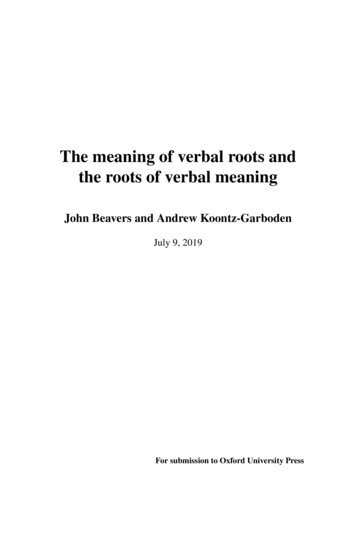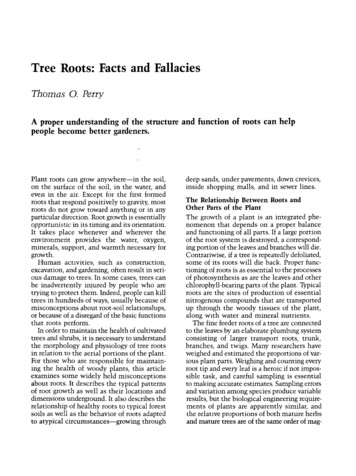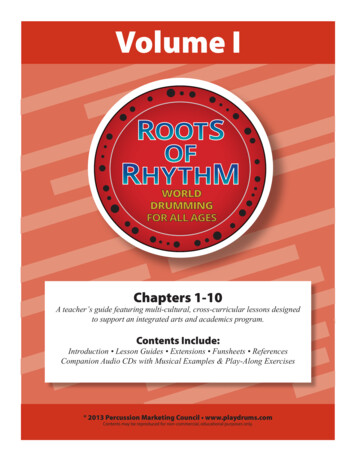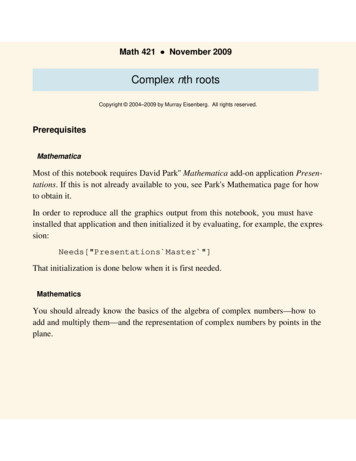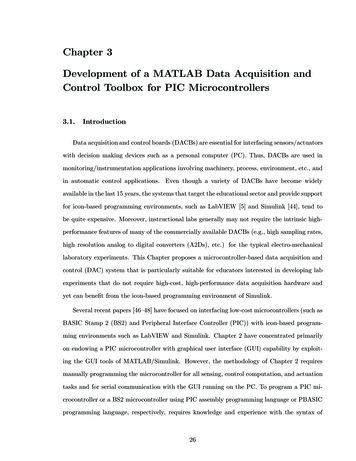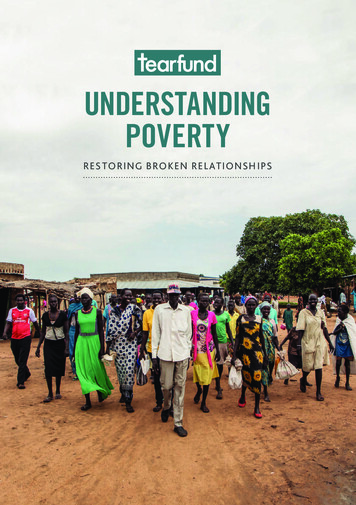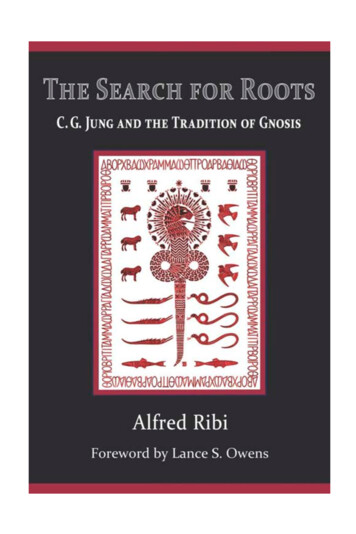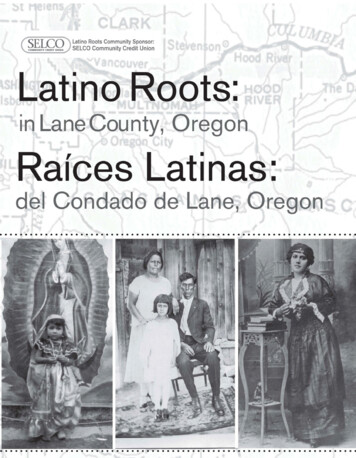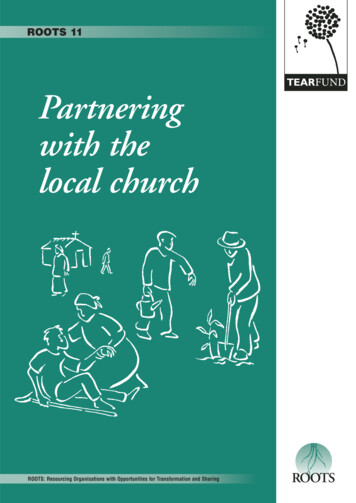
Transcription
ROOTS 11Partneringwith thelocal churchROOTS: Resourcing Organisations with Opportunities for Transformation and SharingROOTS
ROOTS11Partnering with the local church ROOTS 8 – HIV and AIDS: taking action. Looks at howChristian organisations can respond to the challengesbrought by HIV and AIDS, such as reducing theimpact of HIV and AIDS, preventing the spread of HIVand addressing HIV and AIDS issues withinorganisations. ROOTS 9 – Reducing risk of disaster in ourcommunities. Looks at a process called ‘ParticipatoryAssessment of Disaster Risk’, which enablescommunities to consider the hazards they face, theirvulnerabilities, their capacities, and how they can takeaction to reduce disaster risk.by Rachel BlackmanDrawings: Bill Crooks, Rod MillDesign: WingfingerThe author wishes to thank Tulo Raistrick, Dewi Hughes,Tim Chester, René Padilla and all Tearfund staff whospent time reviewing drafts. Thanks also to Tearfundpartner organisations who contributed case studies andfield tested this book.Knowing how Tearfund’s publications are used bypartners and other organisations helps us to improvethe quality of future publications. If you wish to givefeedback on this book, please write to Tearfund oremail roots@tearfund.orgOther titles in the ROOTS series are: ROOTS 1 and 2 – Advocacy toolkitA set of two separate books:Understanding advocacy (ROOTS 1) andPractical action in advocacy (ROOTS 2).Available only as a set.ROOTS 3 – Capacity self-assessment.An organisational assessment tool to enableorganisations to identify their capacity-building needs.ROOTS 4 – Peace-building within our communities.Learning points taken from case studies of Tearfundpartners who have been involved in encouraging peaceand reconciliation in communities.ROOTS 5 – Project cycle management. Looks at theprocess of planning and managing projects using theproject cycle. Describes planning tools such as needsand capacity assessments and stakeholder analysisand shows clearly how to develop a logical framework. ROOTS 6 – Fundraising. Shows how to develop afundraising strategy and contains ideas to helporganisations diversify their funding base. ROOTS 7 – Child participation. Looks at theimportance of including children in community life andin project planning, implementation and evaluation. ROOTS 10 – Organisational governance.Looks at governance principles and issues so thatorganisations can improve their governance structureor set up a governing body if they do not alreadyhave one.All are available in English, French, Spanish andPortuguese.For further details write to Resources Development,Tearfund, PO Box 200, Bridgnorth, Shropshire,WV16 4WQ, UKor email: roots@tearfund.org Tearfund 2007ISBN 978 1 904364 72 6Published by Tearfund. A company limited by guarantee.Registered in England No 994339.Registered Charity No 265464.Tearfund is an evangelical Christian relief anddevelopment agency working through local partnersto bring help and hope to communities in need aroundthe world.Tearfund, 100 Church Road, Teddington,TW11 8QE, UKTel: 44 (0)20 8977 9144Email: roots@tearfund.orgWeb: www.tearfund.org/tilz
ROOTS 11PA RT N E R I N G W I T H T H E L O C A L C H U R C HPartnering with thelocal churchby Rachel Blackman T E A R F U N D2 0 0 71
ROOTS 112T E A R F U N DPA RT N E R I N G W I T H T H E L O C A L C H U R C HR O O T SR E S O U R C E S
ROOTS 11PA RT N E R I N G W I T H T H E L O C A L C H U R C HContentsIntroduction5Section 1 Defining the local church and its roleThe mission of the church: Integral missionSection 2 The relationship between Christianorganisations and local churches710172.1 The need for both Christian organisations and churches172.2 Establishing good relationships23Section 3 Approaches to working with local churches273.1 Church mobilisation273.2 Church and community mobilisation333.3 Church empowerment for advocacy42Section 4 Key issues to consider474.1 Changing the focus of Christian organisations484.2 Working in partnership534.3 Good leadership584.4 Envisioning for integral mission644.5 Facilitating mobilisation714.6 Encouraging use of local resources764.7 Monitoring and evaluation79Section 5 Resources and contacts85Glossary T E A R F U N D872 0 0 73
ROOTS 114T E A R F U N DPA RT N E R I N G W I T H T H E L O C A L C H U R C HR O O T SR E S O U R C E S
ROOTS 11PA RT N E R I N G W I T H T H E L O C A L C H U R C HIntroductionThis book is aimed at Christian organisations that seek to transform communitiesthrough development, relief and advocacy work. These organisations may be churchdenominations, development departments of denominations, Christian networks, Biblecolleges or Christian non-governmental organisations (NGOs). We recognise that insome ways these types of organisations are different. However, as this book is based onthe idea that the local church is central to community transformation, we group all theseChristian organisations together because we suggest that they can all have a similar rolein empowering local churches. We refer to a particular type of Christian organisationwhen they have a unique role.In this book we outline what is meant by integral mission and show the central role ofthe local church in this. We argue that by empowering the local church to carry outintegral mission, Christian organisations can influence community transformation to agreater extent than if they work directly in the community and in isolation from thelocal church.In order to do this, Christian organisations may have to change their thinking and theirrole. A key issue is to break away from the idea of only implementing compact, timebound projects at community level. As integral mission involves local churches reachingout to communities in every aspect of life, we feel that it is helpful to use the word‘initiative’ rather than ‘project’ when relating to local church activities. This is becausemany integral mission activities may be small-scale and ongoing, to such an extent thatthey become part of community life. Indeed, poor people often want to participate incommunity more than projects. The best thing the local church can do is to offer poorpeople a place of welcome and community. A small community initiative may be oneway to do this.Some integral mission activities carried out by the local church may need to be supportedby Christian organisations due to the need for expertise or equipment. These maytherefore seem more like traditional projects. However, in this book we make a distinctionbetween projects and initiatives on the basis of who takes the lead. We use the word‘project’ to describe work in the community which is led by a Christian organisation. Weuse the word ‘initiative’ to describe an activity that is started and owned by the localchurch, even if it receives some input from a Christian organisation.One of the biggest challenges for Christian organisations, including Tearfund, inempowering the local church for integral mission, is to give up the power that we haveover local churches and communities in terms of our resources, contacts and technicalability. It is tempting to use the local church for our own purposes. We hope that thisbook will be helpful as we work out how best to serve the local church, and through it,God’s purposes in the world. T E A R F U N D2 0 0 75
ROOTS 11PA RT N E R I N G W I T H T H E L O C A L C H U R C HThis book is intended to be thought-provoking as well as practical. There is therefore notenough space to make it into a comprehensive handbook that will enable a Christianorganisation to mobilise a local church without reference to other resources. However, wedo raise important issues, provide a few practical ideas to trigger further discussion, andprovide a list of other useful resources.The book starts by defining the local church and integral mission. In Section 2 we lookat different models of interaction between local churches and Christian organisations. InSection 3 we look at three approaches to working with local churches. Section 4 thendraws out key issues to consider when working on a strategy to engage more with localchurches.6T E A R F U N DR O O T SR E S O U R C E S
Section1ROOTS 11PA RT N E R I N G W I T H T H E L O C A L C H U R C HDefining the local churchand its roleBefore we look at how to work with the local church, it is necessary to define what wemean by the term ‘church’. The New Testament uses the word ‘church’ in the followingways: a meeting of Jesus’ followers. This is the most common use of the word. a gathering of believers that meet in a house all believers in a particular locality – the people who belong to a group of believerseven when they are not gathered together believers in a particular locality under the care of a group of elders all believers everywhere – the worldwide church.There are common elements in all the descriptions of the church given in the NewTestament. These are: The church consists of a group of people. (Note: the church is not about buildings.) The group of people are followers of Jesus Christ. The church is the community in which God lives by his Spirit.The church is an expression of the heavenly congregation here on earth. It is God’sprimary agent of transformation in the world. The key difference between the uses of theword ‘church’ given above is locality. For example, it can refer to a group of peoplemeeting in a house or all believers everywhere. As the church is a community of peoplewho follow Jesus Christ, it is appropriate that they meet with one another regularly. It isnot possible for all Christians worldwide to meet together, as lovely as that would be!Therefore, Christians need to meet together in smaller groups, usually in the area inwhich they live. The term we use for this grouping is ‘local church’.This term does not only refer to believers who meet together in a building which isconstructed especially for that purpose. The ‘local church’ may meet in a communitybuilding, school hall or someone’s home. It is usually sustainable and should not be fullydependent on external funding, personnel or resources for its existence. Tearfund’sdefinition of local church is therefore a ‘Sustainable community of local Christianbelievers, accessible to all, where worship, discipleship, nurture and mission take place.’In this book, we use the term ‘local church’ to refer to such groups and the word ‘church’alone to refer to the wider body of Christ. T E A R F U N D2 0 0 77
1Defining thelocal churchand its roleBIBLE STUDYROOTS 11PA RT N E R I N G W I T H T H E L O C A L C H U R C HCharacteristics of the local church Read Acts 2:42-47 and Acts 4:32-35. List all the attitudes and actions of God’speople. Go through each item in the list anddiscuss their meaning. Some arestraightforward, but others may need to bediscussed in depth for their meaning andrelevance. For example, the word‘devoted’ gives a sense of a bindingcommitment or promise, similar to awedding vow. In particular, discuss themeaning of these terms – the apostles’teaching (Acts 2:42); the ‘fellowship’ (Acts2:42); the ‘breaking of bread’ (Acts 2:42);‘everything in common’ (Acts 2:44) and ‘inheart and mind’ (Acts 4:32). Is this what our local churches are like? Ifnot, which characteristics are lackingand why? If we were first-century people who werenot followers of Jesus Christ, how mightwe describe this group of people whomet together regularly for worship andgave things away? Look at Acts 2:47, which says that thefollowers of Christ ‘enjoyed the favour ofall the people’. What does this mean? Isthat the situation for Christians today? Inour local situation, which characteristicsof the early church should we followmore closely in order to be the churchGod wants us to be?While recognising that local churches need leaders, the New Testament does not prescribeone specific way in which leaders (such as elders, overseers or deacons) and the churches theylead should relate to each other. As a result, it is not surprising that a variety of churchstructures or denominations have been formed over the centuries. Denominations andnetworks can be useful for pastoral accountability, sharing of learning, resources and gifts,and useful for enabling local churches to be heard at national level.Christian leaders have argued over whether different structures are right or wrong, buthistory shows us that God can bless people through any Christian structure and that thegodliness of the leader is far more important than the position they hold. History alsowitnesses to the fact that church structures can sometimes come to exist for their ownends. When this happens there is need to refocus the structure on its true purpose ofbuilding up local congregations of Christians.The church is called to demonstrate the kingdom of God as a visible sign of his kingdomin the world. The church is called to be salt and light (Matthew 5:13-16). The churchshould influence situations for the better, preserve good things and bring healing.8T E A R F U N DR O O T SR E S O U R C E S
1Defining thelocal churchand its roleROOTS 11PA RT N E R I N G W I T H T H E L O C A L C H U R C HThe role of the church: pictures of the churchBIBLE STUDY Read 1 Peter 2:4-12. Peter uses anumber of pictures of the church thatindicate the church’s role:A spiritual house (verses 5-8). Peter usesthe image of a building to describe God’speople. A cornerstone is a large stonesupporting two walls at right angles toeach other. What would happen to thebuilding if the cornerstone wasremoved? Who is represented by thecornerstone? Why is it relevant that he isthe cornerstone and not just any stonein the walls? Who do the other stones in the buildingrepresent? Notice that without theseother stones, there would not be abuilding. We cannot be Christians inisolation – we must be together incommunity. The temple was the holiestplace for Jews because it was seen asthe dwelling place of God. People fromall over the known world would travel tothe temple to worship God. Likewise,the spiritual house exists so that peoplecan meet with God.A holy priesthood (verse 5). In the OldTestament the role of a priest was to act asa go-between between God and thepeople of Israel. The priests took sacrificesfrom the people and presented them onthe altar to God on their behalf. However,Jesus Christ’s death and resurrection asthe ultimate sacrifice means that there isno need for the Old Testament type ofpriest any more. In this passage, we seethat all who trust in Jesus are holy priests.Read verse 5. What are the spiritual sacrifices that we areto offer? To answer this question, look atthe following passages: Romans 12:1;Ephesians 5:2; Philippians 4:18; Hebrews13:15-16. Who benefits from these spiritualsacrifices?A holy nation (verse 9) Using the phrase‘holy nation’ would immediately remind Jewsof their own history, when the nation of Israelwas saved out of slavery in Egypt. This was amodel of what was to come when Jesuscame to bring both Jews and Gentiles intoGod’s kingdom. Holy means ‘set apart’. What do you thinkPeter means by referring to Christians as aholy nation?A people belonging to God In what ways can we show we belongexclusively to God, who is King over all theearth? (see verses 9-12) What is the outcome of this? (verse 12)THE ROLE OF THE CHURCH What does this Bible passage tell us aboutthe role of the church? Does being different from the world meanbeing isolated from the world? How can our local church become morelike the community of believers that Peterdescribes? How can Christian organisationsencourage local churches to become morelike the community of believers that Peterdescribes? Are there ways in which theactions of Christian organisations canactually hinder local churches frombecoming what God intends them to be? What is the role of the holy priestsdescribed here? T E A R F U N D2 0 0 79
1Defining thelocal churchand its roleROOTS 11PA RT N E R I N G W I T H T H E L O C A L C H U R C HThe mission of the church: Integral mission1Poverty is multi-dimensional. It is about lacking basic needs. Often, people think ofbasic needs as merely physical – such as food, clothes and shelter. But there are otherdimensions of poverty, such as social poverty (lack of opportunity to interact with otherpeople), political poverty (lack of ability to influence people in positions of power) andspiritual poverty (lack of relationship with God through Jesus Christ).By looking at poverty like this, we can say that most people in the world are poor insome way – occasionally, sometimes or all of the time. For example, someone who ismaterially rich could lack social networks or they may be in spiritual poverty. On theother hand, someone who is materially poor could have a supportive family and be aChristian, and therefore feel socially and spiritually rich.The church is called to meet people's needs through loving them in the way that Godloves them. The church is God’s agent of transformation in communities. However, overthe years, churches have interpreted their mission to love others in different ways: Some churches have focused only on the spiritual aspects of poverty. Their expressionof love to the community has been in proclaiming the gospel. Some churches have expressed love through focusing on people’s material needswithout giving enough attention to spiritual needs. They demonstrate the gospelwithout necessarily proclaiming it. Some churches have actively been involved in addressing all types of needs but havefailed to make the linkage between them. They have treated proclamation anddemonstration of the gospel separately.In this section we look at ‘integral mission’. This term is used to describe the church’smission to meet people’s needs in a multi-dimensional way. We argue that proclamationand demonstration of the gospel should not be separated. Integral mission is aboutspeaking of and living out our faith in an undivided way, in all aspects of life. Withoutintegral mission, the degree to which the kingdom of God can be shown and extendedin this world can be limited.Since churches tend to separate proclamation and demonstration of the gospel, wewill explain integral mission in this section by showing why the separation should notbe made.1 This section draws strongly on Tim Chester’s work in his book Good news to the poor.10T E A R F U N DR O O T SR E S O U R C E S
1Defining thelocal churchand its roleROOTS 11Explanation of termsused in this sectionPA RT N E R I N G W I T H T H E L O C A L C H U R C HProclamation means telling people the gospel, and is sometimes called ‘evangelism’.Demonstration means showing people what it means to be part of God’s kingdom, such asthrough physically helping others to reduce poverty such as physical or political poverty. It issometimes called ‘social action’ or ‘social involvement’ because it involves addressing needs insociety.The term integral mission comes from the Spanish ‘misión integral’ and can also be referred toas ‘holistic ministry’, ‘(w)holistic development’, ‘Christian development’ or ‘transformationaldevelopment’.Case studyExample of integral mission in northeast BrazilA man in the village of Caroá in northeast Brazil heard about Jesus onradio programmes broadcast by Ação Evangélica (ACEV). He invited twopastors to speak in his village and as a result, 16 people becameChristians.Photo: Jim Loring, TearfundAs ACEV began to establish a church there, they saw that people neededaccess to safe water. Building a well posed a challenge – it was a newventure for ACEV’s evangelists. Yet they found that their practical workcomplemented their spiritual work. One community membercommented, ‘The well started everything. It shows us that God loves us,and that through brothers and sisters in Christ, he blesses us.’A community membercollects water from the wellSince then, there have been many changes in the community, includingprovided by ACEV.an animal loan scheme, and government provision of a reservoir afteradvocacy work by the community. Now around half of the community members are Christians.The need for the church to be involved in demonstratingthe gospelSocial involvement is part of what God expects Christians to do:Socialinvolvement isrooted in thecharacter of GodGod is concerned for people’s basic needs, whether spiritual or material. Socialinvolvement is part of his character (for example, see Psalm 146:7-9). He opposes thosewho are responsible for injustice and sides with the victims of oppression. This does notmean that God is biased towards poor people and gives them preferential treatment. Allpeople are important to God, shown in his grace to all people, whether rich or poor.However, in a world where there is bias towards the wealthy and powerful, God’s actionswill always be seen as an opposite bias.God’s character is most fully revealed in the person of Jesus Christ, who showed andpreached concern for the poor (Luke 4:18-19; Matthew 4:23; Matthew 9:35-38;Matthew 14:14; Luke 12:33). T E A R F U N D2 0 0 711
We are called tocare for thosearound usROOTS 11PA RT N E R I N G W I T H T H E L O C A L C H U R C HGod expects us to mirror his concern for the oppressed (see Proverbs 31:8-9 and Isaiah1:10-17). We are to care for those around us (Mark 12:28-34). Jesus told the parable ofthe good Samaritan (Luke 10:25-37), showing that we are to care for people across socialand cultural divides.Case studyExample of integral mission in the UKIn the UK, where the extended family is not as valued aselsewhere in the world, many elderly people feel lonelyand isolated. Some are unable to go out due to illness,disability or age and therefore rarely have an opportunityto talk to other people.Mount Florida Parish Church in Scotland went throughTearfund’s Church, Community and Change process,The elderly people and their befrienders enjoywhich mobilises local churches in the UK to carry outChristmas lunch together in the church hall.integral mission. At the end of the process, it emergedthat a key issue in Mount Florida was the loneliness of elderly people. The church therefore set upa ‘befriending service’ where volunteers regularly visit elderly people in their homes and, ifappropriate, take them on outings.This has helped to inspire self-worth and confidence in the elderly people. One person said, ‘Therest of the day I am on my own, so it’s good to get somebody to talk to to cheer me up.’Another person, who had been suffering from depression, found that being visited gave him a newinterest in living and he began to ask the volunteer about her Christian faith.The links between proclamation and demonstration of the gospelThere is a natural link between demonstration and proclamation: When proclamation of the gospel leads to repentance by those who respond toit, there are social implications. Jesus Christ becomes Lord over every area of theirlives, so that there is transformation beyond the spiritual. In recognition of Christ’sauthority and through a desire to please him, Christians seek to reflect the justiceand love of God in their own lifestyle and relationships, and in society as a whole.James 2:15-18 calls us to do good deeds to show evidence of our faith in Christ.Proclamation therefore leads to social involvement. This social involvement (demonstration), in turn, has consequences for proclamationas Christians bear witness to the transforming grace of Jesus Christ.We should always be aware of our motivation and what we are witnessing to, and ensurethat this is communicated to those around us. Social involvement has to be an integralpart of the mission of the church, but it is important that it is carried out alongsideproclamation of the gospel. As the box opposite shows, social involvement complementsproclamation, and proclamation complements social involvement. Christians are called todo both. We cannot do one in isolation from the other.12T E A R F U N DR O O T SR E S O U R C E SPhoto: Adele Robertson1Defining thelocal churchand its role
1Defining thelocal churchand its roleROOTS 11PA RT N E R I N G W I T H T H E L O C A L C H U R C HThere is sometimes a tendency to separate the death and resurrection of Jesus from hisearthly life. While his death and resurrection are of central importance, there is muchthat we can learn from Jesus’ life and ministry on earth. His way of life and actions are amodel for the mission of the church as much as his preaching. The Micah Declaration onIntegral Mission states2: ‘As in the life of Jesus, being, doing and saying are at the heart ofour integral task.’Proclamation anddemonstration areinseparableProclamation is reinforced by our social involvement The gospel is interpreted in the context ofthe lives and actions of the people who share it and their relationships with one another. If aChristian tells someone the gospel, but does not display evidence of being a Christian throughcaring for others, the perceived value of the gospel to the person who hears it is weakened. Socialinvolvement is an advertisement for God’s kingdom where relationships with God and each otherare restored (Matthew 5:14-16).Social involvement acts as a signpost However, if done without communicating the gospelmessage, it can point people in the wrong direction: Rather than pointing to God, it can point to us. It can wrongly communicate that salvation is about doing good works. It can deny the importance of reconciliation with God by indicating that improving economicand social situations are all that matter.Social involvement helps people in their earthly lives, but does not bring blessing beyond that.NOTE: While it is important to proclaim the gospel as well as demonstrate it, people should neverbe forced to convert. Some religious groups may require people to convert to their religion so thatthey qualify for receiving aid. We believe that this is totally wrong. It is vital that Christians shareunconditional love with everyone, through word and deed. Unwillingness to care for those of adifferent religion is denying God’s grace towards us and towards them.2 The Micah Declaration was drawn up in 2001 at a meeting organised by the Micah Network, a coalition of evangelical churches and agenciesfrom around the world which are committed to integral mission. For further details see www.micahnetwork.org T E A R F U N D2 0 0 713
PA RT N E R I N G W I T H T H E L O C A L C H U R C HExample of integral mission in MaliThe small town of Diré in Mali has experienceddesertification over the last few decades. A localBaptist church has taken action to fight theencroaching desert and ensure that some of theland remains cultivated. The church, with just 15members, calls this the ‘Good SEED’ project. Theten-hectare plot of land is shared between eightlocal people who grow rice, millet, melons andvegetables.In addition to enabling people to feed their families,Church and community members cultivate thethe church hopes that the project will complementland together.its evangelism by showing local people whatChristians are really like. The Project Coordinator says, ‘We are happy to share this land with otherpeople because we love them People believe false things about us If they can work alongsideus in the fields they find out what we are really like and what we really believe.’ One communitymember commented, ‘I am not yet a Christian myself, but my impression is that they are verygood people, and what they teach is true.’Case studyExample of integral mission in the PhilippinesPeace and order was a big problem in oneneighbourhood of Quezon City. Each day there wereup to five killings among rival gangs of teenagers. Apastor decided to move into the dangerous area ofthe neighbourhood and live among the gangs. Thiswas an initiative by the LIFE Project, which is apartnership between the local Batasan Bible Churchand ISAAC, a Christian non-governmentalorganisation.Gradually, as the pastor shared his life with theteenagers, they began to share their lives with him. Ex-gang members study for diplomas.The lives of many have been transformed. Oneex-gang member says, ‘The pastor modelled to us a better life. He was a mentor to us, teachingwhat was good and bad and we were filled with the Word of God.’ Many of the teenagers did notattend school. Batasan Bible Church has helped them to study and gain diplomas. Before theproject, the local shops would shut by six o’clock in the evening because of gang fighting at night.Now the shops stay open much later because the neighbourhood is so much more peaceful.14Photo: Richard Hanson, TearfundCase studyROOTS 11T E A R F U N DR O O T SR E S O U R C E SPhoto: Jabez Production1Defining thelocal churchand its role
1Defining thelocal churchand its roleROOTS 11REFLECTIONPA RT N E R I N G W I T H T H E L O C A L C H U R C H Do we agree with the definition of local church given in this book? Does itreflect our own perception of what ‘local church’ is in our community? If not,what is different? Is integral mission carried out by churches in our community? If not, isproclamation carried out without demonstration, or is demonstration carried outwithout proclamation?Summary We have defined the local church as a ‘sustainable community of local Christianbelievers, accessible to all, where worship, discipleship, nurture and mission takeplace.’ We have discussed what integral mission is – speaking of and living out our faith inan undivided way in all aspects of life. We have identified integral mission as an important part of the local church’s role. T E A R F U N D2 0 0 715
116Defining thelocal churchand its roleROOTS 11T E A R F U N DPA RT N E R I N G W I T H T H E L O C A L C H U R C HR O O T SR E S O U R C E S
Section2ROOTS 11PA RT N E R I N G W I T H T H E L O C A L C H U R C HThe relationship betweenChristian organisationsand local churchesAs discussed in Section 1, local churches have a role in proclaiming and demonstratingthe gospel. However, very often, th
field tested this book. Knowing how Tearfund’s publications are used by partners and other organisations helps us to improve the quality of future publications. If you wish to give feedback on this book, please write to Tearfund or email roots@tearfund.org Other titles in the ROOTS seri
